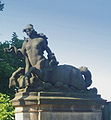Stephan Walter

Stephan Walter (born May 15, 1871 in Nuremberg ; † March 3, 1937 in Berlin ) was a German sculptor .
Life
Walter was born the son of a master carpenter . After studying for two years at the Königliche Kunsthochschule Nürnberg , he first worked in a porcelain factory in Bonn , then in several art studios in Frankfurt am Main . Stephan Walter then continued his studies at the Kunstgewerbeschule in Frankfurt and in 1892 came to Berlin with his teacher Wilhelm Widemann at the Kunstgewerbeschule . During this time he was able to work on the design and manufacture of the architectural jewelry for the Reichstag building . Study visits to Munich and Innsbruck were followed by study trips to Italy, Egypt, Russia and Sweden. From 1898 he was a freelance sculptor, received extensive commissions and took part in many competitions, including for a monumental fountain in Opole, which was designed as a Ceres fountain by another artist. Walter had been a member of the Berlin Freemason Lodge Friedrich Wilhelm zur Morgenröthe since 1910 .
Stephan Walter died in Berlin in 1937 at the age of 65. He was buried in the Old Twelve Apostles Cemetery in Berlin-Schöneberg . His final resting place is in the hereditary funeral of the Gustav and Julius Fröhlich families. In a niche of the wall grave with shell limestone cladding, there is a group of marble figures showing a mourning woman saying goodbye to a dead woman. Walter created the sculpture himself in 1912.
Works (selection)
- 1898: Sower from the time of the Great Elector for the district building of the Niederbarnim district in Berlin; In 1913, the sculpture received the 1st prize at the state art exhibition and the silver medal at the architecture exhibition. The work was considered lost, was rediscovered in the Czech Republic and auctioned off in 2005. The original is now in the Oschersleben City Library (Bode) .
- around 1907: four allegorical figures for the government building in Potsdam
- 1908: two animal figures of otters and two animal figures of greyhounds at the Baumgartenbrücke in Geltow (greyhounds have been missing since 1945)
- 1908: two centaurs on the east side of the Glienicke Bridge between Potsdam and Berlin
- 1912 Pietà and 1914 high relief for the hereditary burial of the Gustav and Julius Fröhlich families in the Old Twelve Apostles Cemetery in Berlin-Schöneberg, which was also Stephan Walter's final resting place; Wall grave preserved
- around 1913: Figures of Law and Power for the Berlin Court of Appeal
- War memorial in Laer (Westphalia)
- Goose thief fountain (location unclear), executed in marble on the order of the building councilor Wilhelm Böckmann
- Two gable coats of arms at Schwedt Castle (destroyed in 1945)
- Maritime trade figurine for the Prussian maritime trade in Berlin, offered by the Gladenbeck foundry in the sales catalog
- Building sculpture on the Magdeburg police building
- Reliefs on the facade of the Hanover Police Department
Centaur at Glienicke Bridge , 1908
literature
- Walter, Stephan . In: Hans Vollmer (Hrsg.): General lexicon of fine artists from antiquity to the present . Founded by Ulrich Thieme and Felix Becker . tape 35 : Libra-Wilhelmson . EA Seemann, Leipzig 1942, p. 132 .
Web links
- The souvenir sower wins hearts in the city magazine Oschersleben
- Stephan Walter on the website of the German Society for Medal Art
Individual evidence
- ↑ a b c d Berlin architecture world. 1901, issue 3, issue 7, p. 251 ( digital.zlb.de ).
- ^ Hans-Jürgen Mende: Lexicon of Berlin burial places . Pharus-Plan, Berlin 2018, ISBN 978-3-86514-206-1 , p. 757.
- ↑ Dirk Riesener: The Hanover Police Department. 2006, p. 64.
| personal data | |
|---|---|
| SURNAME | Walter, Stephan |
| BRIEF DESCRIPTION | German sculptor |
| DATE OF BIRTH | May 15, 1871 |
| PLACE OF BIRTH | Nuremberg |
| DATE OF DEATH | March 3, 1937 |
| Place of death | Berlin |



